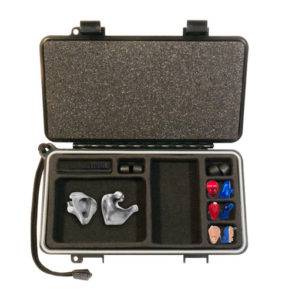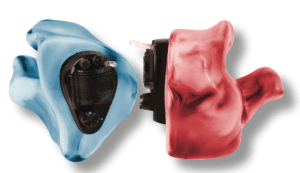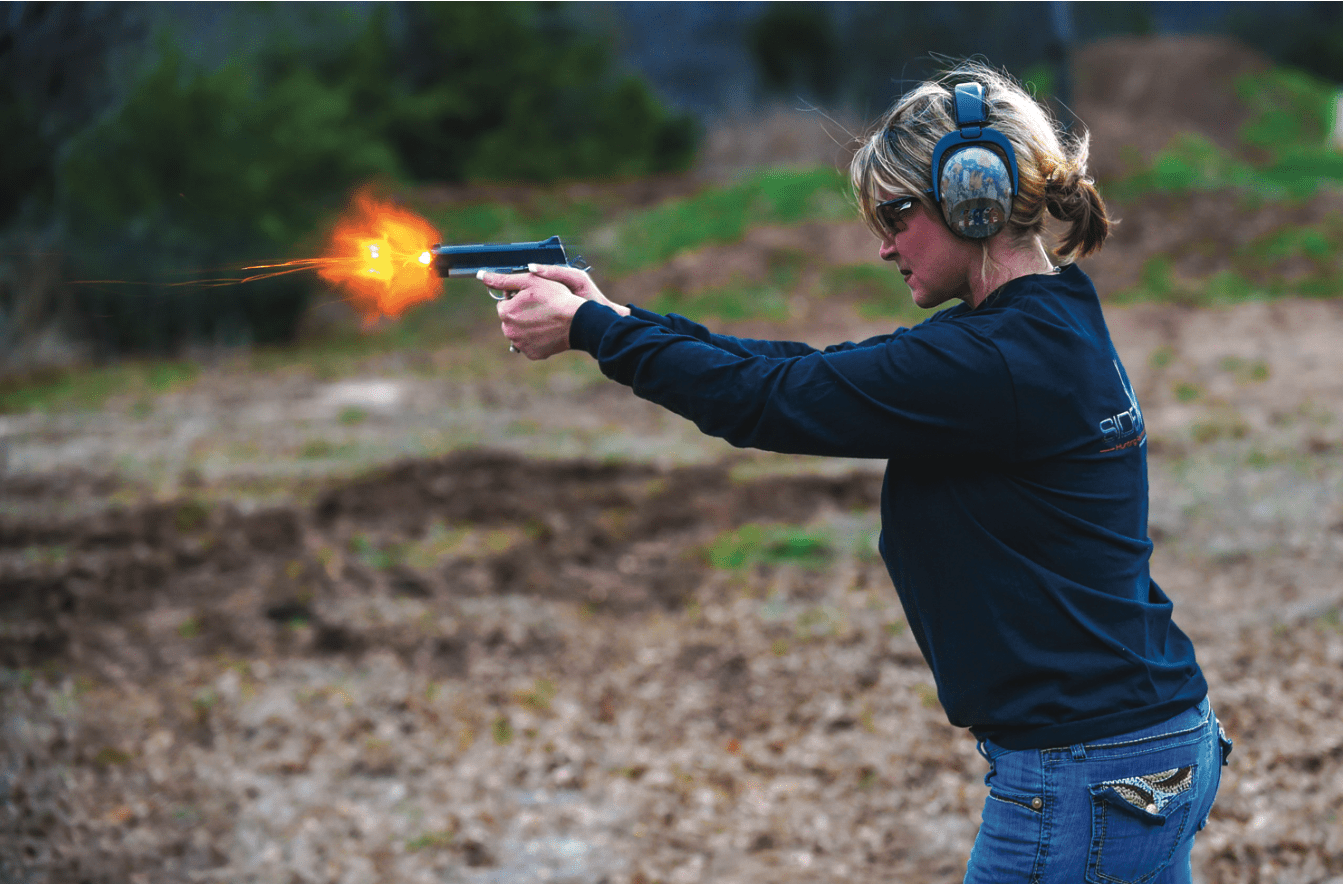- 800.525.2690
- [email protected]
- Mon - Fri: 8:00 - 4:30
2022 Trends in Hearing Protection for Shooters
Shooting is loud. Find out the latest ways to protect your ears.

By: Garry Gordon, MS, and Robert M. Traynor, Ed.D., MBA, F-NAP
Article first published in Ladyshooter Lifestyles.
Boom….!
Every time the trigger is pulled on a loaded shotgun the average intensity of impulse noise is between 150 to 161 Decibels! This research was accurately conducted by Rasmussen (2009) and cited by Meinke 2017. Rasmussen and colleagues found these levels from shotguns at the left ear of a right-handed shooter. As far back as the 1970s, Krammer, Ph.D. from Ball State University was hired by the U.S. government to see if it was possible to acoustically fingerprint a weapon. While Krammer was unable to find firearm acoustic imprints he noted that the impact sounds from these weapons were approximately 14 dB beyond the threshold of pain and more than sufficient to cause a sudden hearing loss or acoustic trauma.
With the introduction of muzzle brakes and porting, the risks of hearing loss from rifles and shotguns increased dramatically. Adding to the complications of such noise exposures, 30%-40% of those who participate in shooting sports complain of tinnitus or ringing and buzzing in the ears. Treatments for tinnitus vary and can be managed by consulting several medical and audiological networks such as the American Tinnitus Association (ata.org). Further, shooting from inside an enclosure such as a goose or duck blind will add to the sound intensity. There is no way to “sugar coat” this problem: hunting and other shooting sports without adequate hearing protection will permanently damage hearing.
According to the literature, untreated hearing loss is rampant with 1 in 5 people not doing much about it until it becomes a serious hinderance to daily activities. In fact, the audiology literature states that those with hearing loss wait 5-7 years after they know they have a hearing loss before they seek treatment.
Even now, with all the publications regarding the dangers of excess noise exposure, Loughran (2020) found that the number of shooters across the board (including hunters and casual plinkers) using ear plugs to protect their hearing ranged from 3%-14.6% and very few indicated they always or often use ear protection. For many years the results of reduced hearing were thought only to be hearing difficulties, but since enlightenment by the studies of Lin et al (2013), we also know that untreated hearing loss contributes to diminished thinking abilities and the progression of dementia and Alzheimer’s disease. The list of other comorbidities goes on and on. So exactly what are the options for hearing protection in shooting and hunting sports?

Options Available to Hunters and Shooters
For most shooters custom fit earplugs offer positive benefits. These products are typically made from high grade room temperature curing silicones that can be manufactured “on the spot.” In this case, the ear impression becomes the finished product and, typically, requires buffing and slight modification in addition to a silicone coating on the outside surface to obtain a good a seal with the finished product. When correctly constructed the average noise reduction rating (NRR) is 30-32 dB.

The second custom earplug option is fabricated from heat curable silicones. These require ear impressions to be sent to a laboratory for processing and, in many cases, can be modified with filters or music transducers. Laboratories using today’s current technology can digitally record the ear impressions enabling most end users to simply call the provider and/or manufacturer and place a new order without requiring new ear impressions. Additionally, if the client has a good set of custom plugs these may be used as an ear impression and digitally recorded. This process has been especially helpful during the COVID pandemic, permitting shooters to order replacement custom earplugs without obtaining new impressions.
A growing trend for hunters, range masters, shooting instructors and shooters has been the use of electronic devices, either in the form of custom molds or earmuffs. For most, but not all shooters, the custom version has been well accepted because they do not interfere with glasses or positioning of a rifle or shotgun. The majority of these 21st century protection devices are digitally programmed for better sound clarity and often include a memory button that can change the frequency response for filtering out background sounds, such as the wind. Many also include a removable lanyard which hunters often request to minimize the risk of loss. Traditionally, the majority of these products have been manufactured so that the portion inserted into the ear canal (the SHELL) is made from a Lucite or hard material. When made properly the NRR (noise reduction rating) for most products will be 22 to 26 dB.
The newest choice, offering better sound suppression, are electronic modules that can be fit to the ear canal with either a high-performance foam tip or inserted into a custom silicone providing an estimated NRR of 31dB – 32 dB.
Electronic circuitry within the device is designed to compress loud sounds before they reach dangerous levels. These devices are not marketed as hearing aids but are classified as assistive listening devices, since hearing aids are considered a medical device. Additionally, there are ear protection devices (wired or Bluetooth) often used by trap shooters or motorcyclists that can be used for listening to music or communication.
Hearing Aids That Are Hearing Protectors
 Many shooters using electronic ear protection often ask about having a multi-functional device that can be used as both an ear protector and a hearing aid. The devices come with two interchangeable couplers to the ear, one with a solid tip for hearing protection or for use with custom plugs and a second tip that is open for use as a hearing aid. These dual-purpose devices may be taken to any of hundreds of designated audiology clinics and reprogrammed to a different hearing profile for more hearing benefit and/or upgraded to a higher performance hearing technology. The design of these dual- purpose, rechargeable instruments is the latest in sophisticated technology standard with up to 4 memories and the ability to connect via Bluetooth to a cell phone or TV — truly the ultimate in hearing benefit and hearing protection technology and utility.
Many shooters using electronic ear protection often ask about having a multi-functional device that can be used as both an ear protector and a hearing aid. The devices come with two interchangeable couplers to the ear, one with a solid tip for hearing protection or for use with custom plugs and a second tip that is open for use as a hearing aid. These dual-purpose devices may be taken to any of hundreds of designated audiology clinics and reprogrammed to a different hearing profile for more hearing benefit and/or upgraded to a higher performance hearing technology. The design of these dual- purpose, rechargeable instruments is the latest in sophisticated technology standard with up to 4 memories and the ability to connect via Bluetooth to a cell phone or TV — truly the ultimate in hearing benefit and hearing protection technology and utility.
Do Not Hesitate to Ask Questions
As a result of advanced technology new and better items are now available for those who want to minimize the risk of hearing loss and/or its complications such as tinnitus. Following are suggestions for obtaining high level hearing healthcare:
– Who is the manufacturer of this product and what is the warranty?
– What is the process to get service or follow up? Do I call a specific office, or reach someone on a cell phone who has no office?
– If service or repair is required, how long does it take and what is the average cost?
– Providers should be able to describe how each product works in addition to the Noise Reduction Rating.
– In the event the client is not happy with the results what is the privilege to return?
– Where were you trained and how long have you been in business? Look for someone who has experience and proper training.
– Proper ear inspections and in some cases hearing testing should be conducted before any fitting with a hearing protection device. You have the right to ask what they are looking for during an ear examination.
– What about fitting children who are growing and beginning to learn the sport? It is critical to have the child or parents stay on top of any changes with growth requiring refitting. In some cases, custom hearing protection devices may simply be recoated with a seal coater to create a better fit.
– For clients who prefer earmuffs or generic foam, or silicone plugs these come with several options and should never be downgraded should this be the choice that best meets their needs.
– Finally, what is the bottom-line expense for my purchase in addition to the length of the warranty. In some cases, extended warranties are available at the time of purchase.
Epilogue
Clinical data verifies that the risk for a noise induced hearing loss is extremely high in shooting sports, so it is important to look for someone who will take time to answer questions and provide options for the absolute best in hearing protection. If there are questions about your hearing, see a hearing health care professional for an accurate assessment. There are numerous
sources for receiving an accurate hearing test in a sound treated environment.

